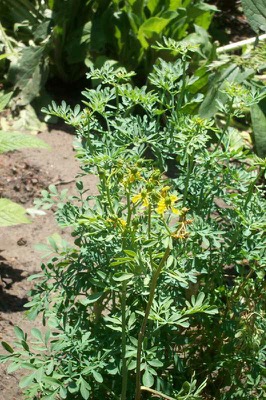
Ruta graveolens
Category: Shrub
Family: Rutaceae
Origin: Southeastern Europe
Evergreen: Yes
Flower Color: Yellow
Bloomtime: Summer
Easily grown in moderately fertile, dry to medium moisture, well-drained soils in full sun. Plants tolerate some light shade. Plants also tolerate poor soils as long as they are sharply drained. Drought tolerant once established. Plants perform well in hot and dry sites. Avoid wet soils. Winter mulch is important in the northern parts of this plant's growing range. Prune back plants to old wood in early spring. Propagate by seed or cuttings.
Ruta graveolens, commonly called rue, is native to southern Europe. It is a glabrous, glaucous, woody-based, shrubby perennial with aromatic, fern-like, compound leaves. It typically grows in a mound to 2-3’ tall. In some parts of the U.S. (particularly the northeast), it has escaped gardens and naturalized along roads, fields and disturbed areas. Notwithstanding its many historical uses, it is primarily grown today for ornamental purposes. Pinnately divided, blue green leaves (to 3-5” long) have oblong/spatulate segments. Foliage has a pungent aroma when bruised and leaves have a bitter taste. Small, 4- to 5-petaled, dull yellow flowers in clusters (flattened corymbs) bloom above the foliage in early summer. Fruit is a brown seed capsule. Ornamental value lies in the delicate blue green foliage. Rue was historically used for a large number of medicinal purposes, but effectiveness and safety concerns now discourage such uses. Leaves are toxic if ingested. Handling plants may cause dermatitis.
source: Missouri Botanical Garden
return to Perennials
